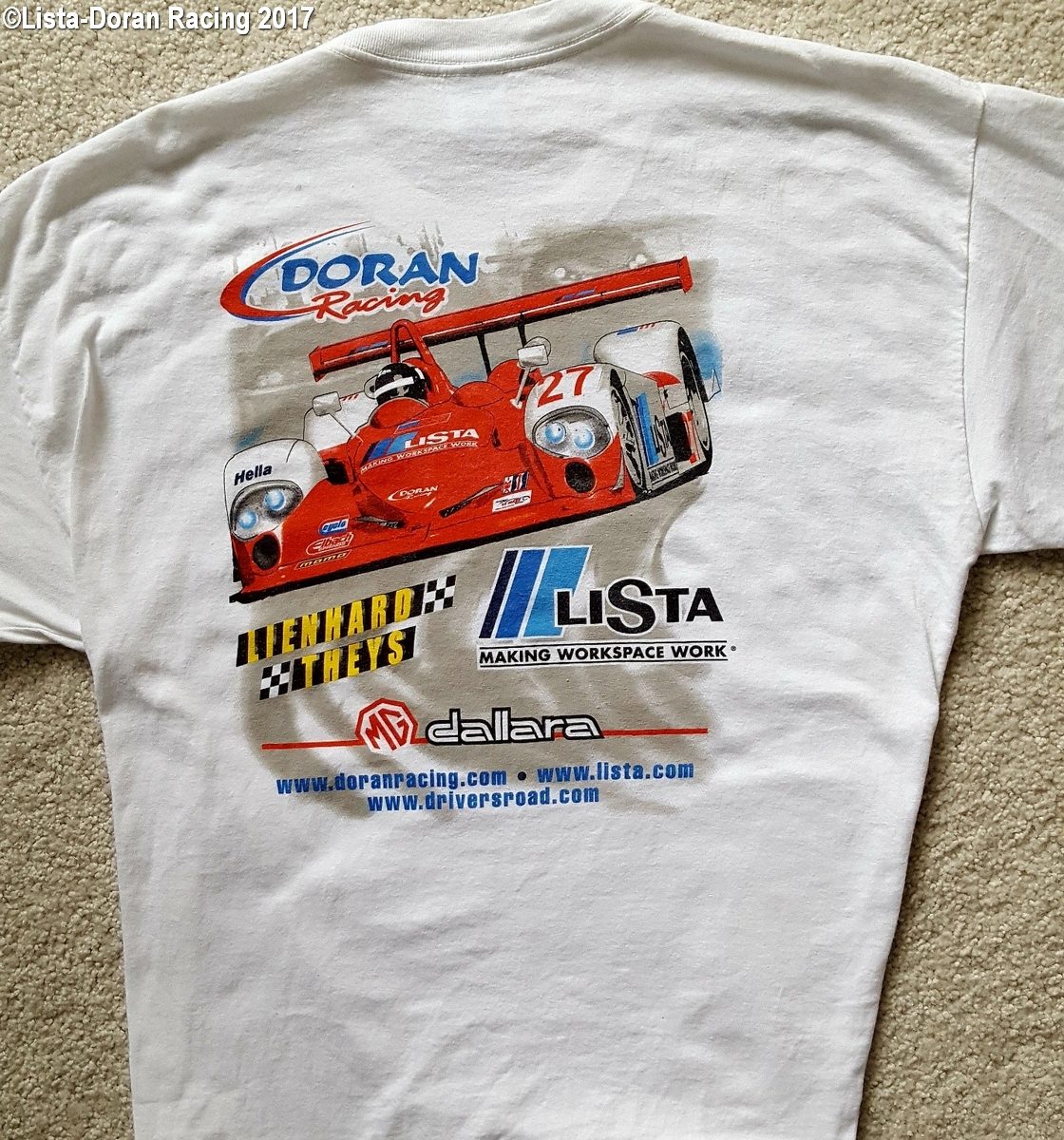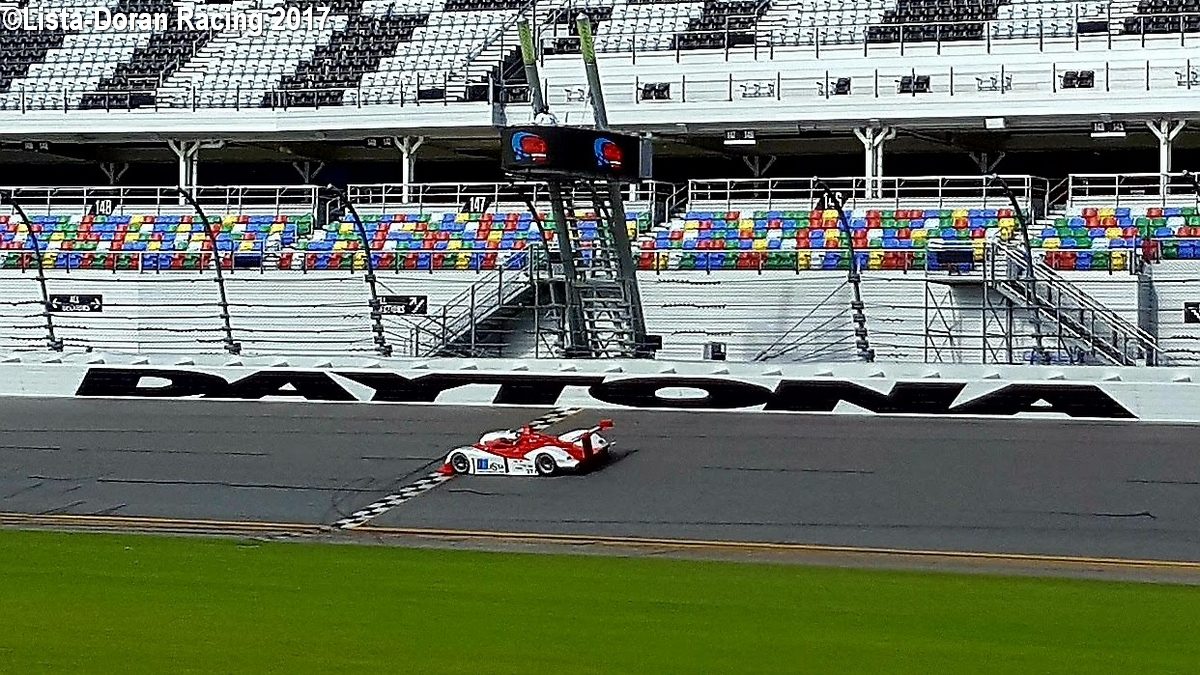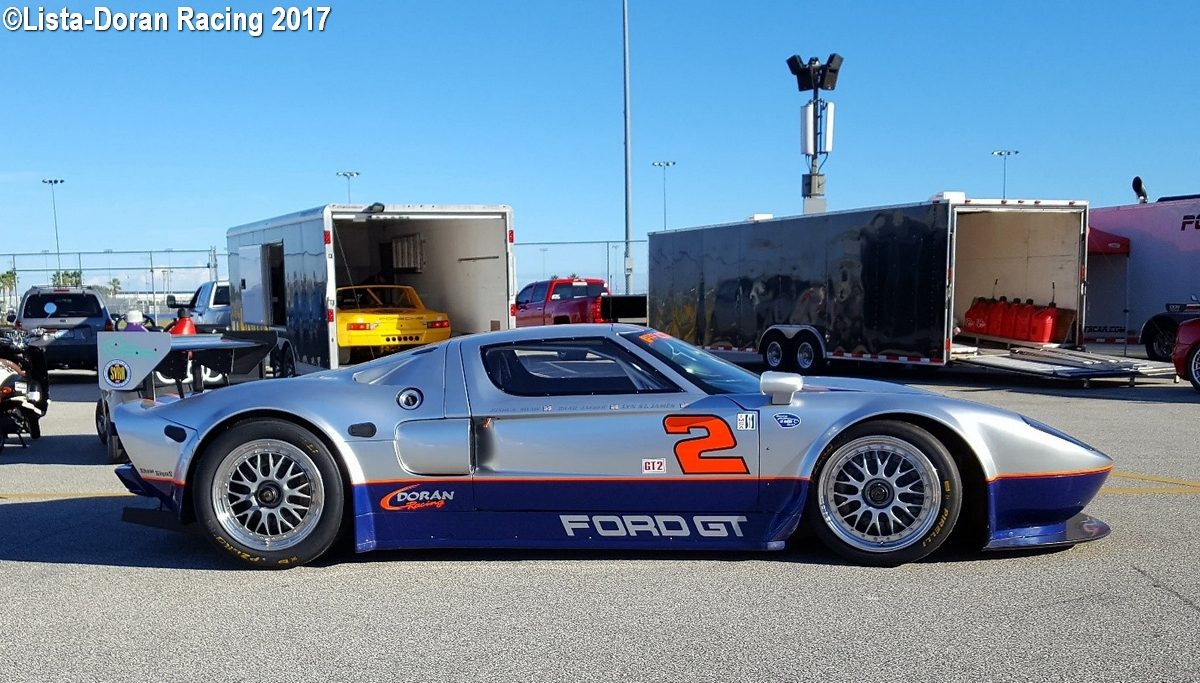A new year, a new beginning – we kick off 2019 with a fresh approach and a new contributor to our site, Martin Raffauf. Martin has been a familiar figure in the IMSA paddocks for well over 30 years working in a variety of teams. At the Le Mans 24 Hours in 1998 Martin was part of the Moretti Racing crew honoured by the ACO, being awarded the prestigious ESCRA Trophy. So a big welcome to Martin who brings us the behind the scenes story of the winning team from the 2002 Rolex 24 Hours. In a neat postscript to that tale he returned with the same guys and the sister car some 15 years later to Daytona International Speedway………..so enjoy the first of hopefully many pieces to enjoy.

Perseverance pays off – 2002 Daytona 24 hours > Replay 2017 (The reunion of car and team at the 2017 Daytona 24 Historics race)
2002 was a transition year for the 24 Hours of Daytona. It would be be the last season for the open cockpit sports prototype cars that had basically run in IMSA, USRRC and Grand-Am since 1994. In 2003 Grand-Am was switching to the new Daytona Prototype, a closed cockpit car built to a completely different rule set.

Doran-Lista Racing entered one car at this race, a Dallara SP1-Judd. The team was basically a partnership between Fredy Lienhard, the Swiss Industrialist, and Kevin Doran, who ran a race team out of his shops near Cincinnati, Ohio. The team was sponsored by Lista, Fredy’s company in Switzerland (with a US manufacturing plant). Lista was and is involved in the production of industrial cabinets, work shop equipment and office furniture. Fredy had started racing in IMSA in 1995 running a Ferrari 333 SP. For the 2002 season he purchased two Dallara SP1 LMP Chassis (#001 & #005). These were the cars built for the French Viper Team Oreca outfit with Chrysler and PlayStation sponsorship to compete at Le Mans in 2001. The SP1 was a descendant of the all conquering Audi R8, which was also built by Dallara. The engines used were the 4.0 liter Judd GV4 V10, which was a derivative of their earlier 3.5 liter F1 engine. Subsequently the GV5 evolution was also used. The engines ran under the ACO/FIA restrictor formula and horsepower in this restricted form was probably in the range of 610 hp, maybe a little more in sprint trim. Most of the cars we would run against were older designs, like the Riley & Scott Mk III, and Risi Competizione’s Ferrari 333 SP. In addition Riley & Scott had developed a new Mk III C, and would run this as a factory entry for Jim Matthews. Most of these cars were well sorted and a known quantity to those running them. The Dallara was almost brand new to our team, and though we had raced it at the Daytona Finale in November 2001, the team was still learning the car and sorting out the setup.

The Major competition to us at this race would come from the Riley & Scott Fords entered by Dyson Racing, the Risi Competizione Ferrari, the Champion Racing Lola Porsche, Jon Field’s Lola Judd and the Factory Riley & Scott Mk III C.
The driver lineups were very good. We had Fredy, Didier Theys, Mauro Baldi and Max Papis. The Dyson cars would be led by James Weaver supported by Rob and Chris Dyson, Butch Leitzinger, Elliot Forbes-Robinson, Dorsey Shroeder, and Oliver Gavin. Jim Matthews’ team consisted of himself, Scott Sharp, and Robbie Gordon. The Champion Porsche was driven by Andy Wallace, Hurley Haywood, Sascha Maasen and Lucas Luhr. The Risi car had Stefan Johannson, Eric van de Poele, David Brabham and Ralf Kelleners. So the driving competition would be stout, plenty of winners and champions in that group.

The Dallara was very quick in Practice and Qualifying. Didier Theys duly took Pole Position, so we felt good about the car’s potential. However, we had no idea if it would run for 24 hours. It was nice to see the fax on the Doran Racing truck blackboard the next day, from the Dallara Factory in Italy, congratulating us on the Pole and wishing us success in the race.

That night Kevin (Doran) called a team meeting in our food tent which was behind the pits, down near pit exit. He thanked us all for the work so far, and remarked that we had a fast car, but he was not sure if we had a reliable car, as we had no experience with it over this distance. He asked us to not lose hope or focus, as strange things had happened in the past in the various Daytona 24-hour races. I mentioned that I had seen several as I had been coming to this race since 1971. I witnessed things such as Pedro Rodríguez’ 917 losing a lead of over one hour in 1971 while his mechanics rebuilt his gearbox. He went on to win anyway. In 1992 the attrition rate had been very high, and a Dan Gurney entered Toyota won the race after spending more than two hours in the pits rebuilding the gearbox. So anything could, and usually did, happen, at Daytona.

The race started well for us, with Didier taking an immediate lead and we ran strongly for the first 10 hours. The Champion Lola Porsche came to the pits on the warm-up lap to replace a spark plug, and spent most of the first hour in the pits. The Risi Ferrari challenged for the lead during the first five hours but eventually dropped out with a broken transmission. Both Dyson Fords were out of contention early on and retired mid-race with engine failures. The race soon settled into one between us, the R&S factory car of Jim Matthews, the Ascari and the Field Lola B2K/10. After 10 hours the Ascari’s engine went bang and then we started having electrical problems, and the battery needed to be changed. This was an awful job on this car, as the smallish, lightweight battery was stuck in the bottom of the right front side of the cockpit underneath an electrical panel, so was hard to get at. The Matthews’ Riley & Scott then took the lead but was soon in trouble with its own electrical issues resulting in no headlights. This took a while to fix, as they could not figure out what the problem was. We watched each other closely, as we were in adjacent pits separated only by a break in the wall. This meant that through the night we would leapfrog each other for second place, depending on the timing of the various problems.

Meanwhile the Jon Field Lola was circulating at a slower pace, but had pulled out a lead of a few laps. Around 4 am, the Matthews’ car pitted with a broken exhaust which had to be changed. That was a messy job on a 6.0 liter Elan (Ford) engine while it was hot. We thought we had finally left them behind, when we had to change another battery. So, at daybreak we were about 7 laps behind the Field Lola-Judd and about 15 laps ahead of the Matthews’ car. Max Papis was driving and pushing hard to try and close the gap to the Lola. At around 8.30am, the Lola broke a drive shaft and was towed back to the pits as it was in a dangerous place on the track.

After some work, it went out again, but stopped almost immediately with a broken input shaft in the transmission. Max then took the lead as he made up the laps on the stationary car. Tatiana Fittipaldi (Emerson’s daughter) was in our pit, as she and Max were dating at the time. So, we were giving her a blow by blow account of the race progress, as Kevin and Max discussed the race situation over the radio, and the rest of the crew listened in on our headsets. At this time we were trying to slow Max down, as we had a large lead over the second placed Riley & Scott. And since the Dallara was an unknown car at this distance, we did not want to push any harder than we had to.

At about this time with 6 hours to go, I asked John Judd Jr., our engine man, “Well the engine ran for 24 hours on the dyno right?”. He said, “Actually no, we never got one to run for more than 20 hours on a dyno”. Great, I thought to myself. I’d hate to come this far and have it blow up now. He said, “We just keep going and see what happens.” Most of the other teams were surprised it was still running now after 18 hours. Jim Matthews told me later, he fully expected us to drop out with engine failure. In 2000 he had run a Reynard-Judd (the same engine we had) and finished the race, but he had spent some 5 hours in the garage changing gearboxes, so it was not a full 24 hours of racing.

Since about the 12-hour mark, Kevin had been having us check the rear wheel bearings on each pit stop. As again, we had not run this car for that long, and didn’t know what to expect. The right rear had started getting loose. If we were racing for the lead, we would have left it, but since we had a cushion, Kevin decided we would change it. We just changed the whole upright, which caused us to lose about half our lead. Luckily the car had no other issues as the clock ticked on. With about 20 minutes to go, we called Mauro Baldi in, to put Fredy in for the finish. It was his car and his team, so it seemed fitting, and the crew wanted him to finish the race. He took the Checkers and became the second Swiss to win Daytona after Jo Siffert some 34 years prior. It made front page news in Switzerland, so we were all happy for him. I had been fortunate to be on a team that won Daytona for the 3rd time (1981, 1998, 2002).

Fredy was a master at matching business to racing. He used racing as a marketing tool for his business and was very good at it. I asked him once how he related the two. He explained how business could learn a lot from racing. Teamwork, preparation, determination, organization, and planning. Fredy was successful at both, and we were proud to be associated with him.

Fredy still owns the winning car. Today It sits in his museum/ automotive learning center, Autobau, in Romanshorn, Switzerland.
2017

Fast Forward to 2017, 15 years later. The winning Dallara from 2001 has been part of the collection in Fredy’s Autobau for years, while the backup car, #005, has sat in Kevin Doran’s workshop on display in Lebanon, Ohio since 2002. For 2017 Fredy Lienhard decided we should run the car at the HSR Daytona 24- hour historic races. It would be a reunion of sorts, 15 years later. Chassis #005 would be prepared and entered.

The HSR (Historic Sportscar Racing) sanctions various vintage races in the USA, one of which is run every year at the famed Daytona International Speedway in Florida. It is a format very similar to the Le Mans Classic in France. Groups of cars (6 groups) basically run four times for a little less than one hour. For example, the Dallara, in group D (Sports cars from 1994-2003) would run at 4pm, 10pm, 4am and 10am over the course of the 24 hours. Cumulative time would determine the finishing order. Although, this is not really a race per se, as a lot of the cars are not driven too hard, as they are of course, old.

Some of the old team were still around. Fredy, his son Fredy Jr., and Didier Theys would do the driving, (Fredy and Didier were two of the race winning drivers in 2002, while Fredy Jr, did drive in some of the IMSA races he did not drive at the 24 hours that year) Kevin Doran’s organization would prepare the car. A few of the old crew from 2002 were available including myself, Dave Doran, Don Caesar, Glenn Smith, Dee Drook and Russ Faber, and of course, Kevin Doran, the team leader.

The car was prepared, and gone thru, as it had been sitting for some years. A five-liter Judd V10 was installed (the engine we ran in late 2002, not at the 24 hours, which was the 4-liter version) A paddle shift system was installed to assist the drivers. This was a modification that was not used in 2002, as then the car had a regular manual transmission shifting system. The team had tested the car some weeks before, and all had worked perfectly. Didier had done a 1:42 lap at Daytona, a few tenths slower than his pole time of 15 years before.

We unloaded the car with high hopes on Tuesday of the race week. It looked pristine sitting in the garage.

Wednesday practice started, and so did the problems. Didier completed a few laps, turned it over to Fredy and then Fredy Jr. Fredy Jr, noted there were some issues with gear shifting that just did not seem quite right. He attributed it to his lack of recent experience in the car, and not having driven the paddle shift system in 2002. We all agreed. Actually we should have paid attention to what he was saying. Usually when a driver tells you something is not “quite right”, it isn’t. The issues got worse, the car would get stuck in gear, jump from 4th to 2nd, that kind of thing. We returned to the garage and removed the gearbox internals, which on the Dallara is a side removal on the right, not a rear removal. None of us really remembered the process for this, so the first time was a bit ragged, but we would get much better at it as the week went along!

The ragged shifting had destroyed several gear dogs and dog rings, and there were a few pieces broken in the paddle system. All this was replaced, and we went out again. A little better, but still the same issue, out came the gearbox again. More destroyed dogs, this time a bad sensor was found on the box, which may have contributed to the original problems. In the meantime the engine had started acting up. Didier reported that upon shifting into 6th gear in the Daytona east banking, the engine would seem to lose about half the cylinders. The Judd support guys, along with Kevin and Noah Bailey (team data engineer) pored over the data, and the determination was that one of the ECU boxes might have gone bad. This was replaced.
The new ECU fixed the engine issues, but the gearbox was still acting up. At this point it was Friday, and the race was starting on Saturday. We had already missed qualifying and would be starting in the back, so Kevin decided to just put the manual linkage back on, rebuild the internals once again, and we would go with that. Saturday morning in a warm up, all worked perfectly, engine and transmission. The team was very relieved.

The race got underwayand we maintained competitive speeds. Our main opposition was another Dallara, a later Oreca one, A Riley and Scott MK III C with a large engine, and some Generation 2 Grand AM DP (Daytona Prototype) cars. There were of course many GT cars from that era running also.

In the first night session, Didier Theys had a scare when the right rear Avon tire disintegrated in the east banking in 6th gear. Luckily, he got it back to the pits without major damage. In the last stage at 10 am Sunday, Didier started, passed all 5 cars in front of him, and set the fastest race lap at 1:40.7. He came in for the mandatory 3-minute pit stop, and turned the car over to Fredy Lienhard Jr. We looked like we may get a podium finish, but it was not to be as another Avon tire disintegrated. Fredy was able to get the car back to the pits without damage, but the loss of time due to extra stops and tire failures cost us and we ended up 4th overall, and 2nd in D-1 category behind the other Dallara of Flourent Moulin who won the D group race.

It had been a grand event. The team’s other car, a 2006 FIA GT3 Ford GT had won its class and finished 10th overall in Group E. It was driven by Brad Jaeger, Lyn St. James and Memo Gidley.

What would become of the grand old Dallara? The future is undecided. But for now, it was back to the showroom! It had been a great journey back in time bringing back all the memories of the Rolex 24 in 2002.
Martin Raffauf, January 2019

